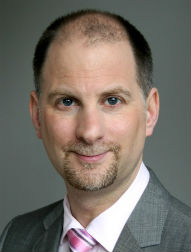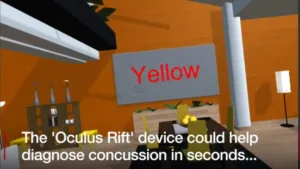VR and some related technology is turning out to have a number of very interesting medical applications, going beyond the use of VR experiences that are designed to help people with psychological issues such as phobias. The latest use is in detecting concussion, a hot topic for a number of sports.

 Dr. Michael Grey of the Universities of East Anglia and Birmingham in the UK, has been working on a test that is administered using an Oculus Rift to test balance. Those that are affected by concussion are less able to balance while following instructions. The aim is to eventually have a simple test that can be used to make decisions, especially when players want to continue despite head impacts.
Dr. Michael Grey of the Universities of East Anglia and Birmingham in the UK, has been working on a test that is administered using an Oculus Rift to test balance. Those that are affected by concussion are less able to balance while following instructions. The aim is to eventually have a simple test that can be used to make decisions, especially when players want to continue despite head impacts.
The test ’tilts the room’ that the VR viewer is seeing and this allows the detection of relatively subtle neurological changes that might not show up in the kind of standard neurocognitive tests that are currently used for concussion detection. Dr. Grey is working with football authorites in the UK to develop the tests and the BBC has a short video that shows it. The BBC also had an interview with Dr Grey (check at 2:43:00) who confirmed that the test really checks the physiology going beyond the checking of standard neuropsychological tests.
As the room rotates (slowly), someone with concussion tends to go off balance. At the moment, the test is just part of a set of tests.
Concussion test – capture from BBC video
At the moment, Dr Grey is not seeing funding from the sports authorities.
Dr Grey has also been using VR in helping sufferers of neurological problems and head injuries as well as strokes and degenerative conditions including Parkinson’s and dementia. Using VR, along with platforms and treadmills and other equipment to make experiences more realistic to life, physiotherapists can make much more sophisticated training programmes that are also more involving and less boring than traditional exercise. There’s another BBC interview online that is also available as a transcript. (the audio item starts at 8:15). The group has seen improvements in balance and walking, part of which simply comes from the enjoyment of doing the exercises (such as simulating walking on a rope bridge or even driving a car).
Gaze Can also be Used
Regular readers of Display Daily will know that I’m very keen on the development of gaze, for a variety of applications. Gaze tracking can be used to augment the desktop computing or gaming experience, can help VR to focus on providing graphics processing to the part of the display where the user is looking (foveated rendering) and the Fraunhofer IIS is looking at optimising video streaming using gaze to deliver high resolution at the point of interest.
However, at CES, we spoke to RightEye which is working on gaze for analysing a number of health issues, including concussion. At the show, the company explained to us that the way that the eyes track images, especially moving images, is very different in cases where the viewer has concussion, or is suffering from diseases including Parkinson’s disease. The company concentrates on developing the software for the tests and is ‘hardware agnostic’ when it comes to eye-tracking equipment.
In the case of concussion, sufferers may have problems tracking a target that is smoothly moving in a circular pattern and the company told us that the pattern for affected users is very distinctive.
![]()
As well as illness and concussion, gaze tracking can be used to test for autism. As we reported to subscribers in our report from the European Congress on Radiology in 2015, JVC Kenwood has developed software for detecting autism using gaze, and has subsequently published a paper in Molecular Autism that indicates that the technique is useful in tracking where viewers look when presented with images of people. The group with autism spectrum disorder (ASD) showed significantly less fixation time at locations of salient social information (i.e., eyes in the movie of human faces without lip movement and people in the movie of people and geometry) than age-matched males with ‘typical development’.
VR and Vision
Len has written several times of the advantages and use of VR as a way of checking for issues of vision (most notably Of 3D (and VR) Headaches) and Matt has written of work in the US on the use of VR in the treatment of phobias and other psychological issues. (Psychology and Immersive Storytelling with VR – subscription required). Similar work has been going on in the UK (VR Used to Treat Mental Disorders – subscription needed).
So, it seems that VR, especially when it is combined with integrated gaze recognition, is developing a solid body of different applications in medicine and health. I’m expecting to see more of this kind of application this week as I’ll be at the Laval Virtual event in France. Bob

